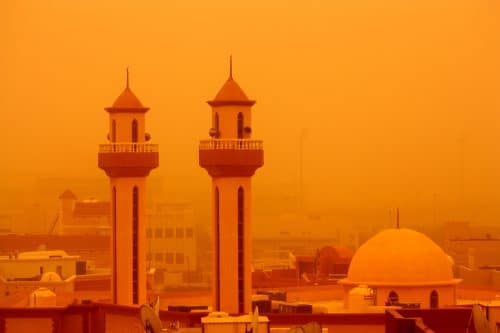Summary and forecast: The summer of 2016 was the hottest in history and the future of our region will be even hotter.

By Dr. Daniel Mader, Angle, Science and Environment News Agency
August 2016 was the hottest month since official measurements began, according to the data collected by the American agencies NASA and-NOAA. This is the 16th month in a row that average monthly global temperature records have been broken. At this rate, 2016 will be the hottest year since records began, a record that will be set just one year after 2015 broke that record.
It is understood that records that are broken in one month or another, and even annual records, do not indicate climate change, but today, after almost 140 years of global warming, we are already certain that significant climate change is occurring in the world and that it originates from human activity.
In Israel, unlike the previous summer which was peaceful with significant heat waves and heavy haze, the current summer was relatively comfortable and without severe heat waves. However, the average temperatures in most of the country were higher than average, especially at night.
Hot in Kuwait
The situation with our neighbors was completely different. Our neighbors to the east, for example, suffered greatly. In July, were measured in Kuwait 54 degrees Celsius. If this measurement is officially approved by the World Meteorological Organization, then it is the highest temperature measured in the eastern half of the earth (Asia, Europe, Oceania and Africa), and it compares to a measurement conducted here, at Tirat Zvi, in 1942 (the reliability of the test from 1942 is subject to in doubt). It is also possible that the new measurement is the hottest ever, because the current world record (56.7 degrees Celsius) was measured in Death Valley in the USA in 1913, and even here it is not certain how reliable this measurement is.
A combination of high temperatures and high humidity resulted in the United Arab Emirates and Iran a heat load equal to60 degrees Celsius. In entire areas of these countries, citizens were asked not to come to work and to leave their homes only in the evening and at night. According to estimates, the heat waves this summer caused the GDP to shrink in Iraq at 10-20 Percent. Iraqi refugees who were displaced from their homes due to the fighting in the area, live in tents and are exposed to the intense heat and in hospitals there is an increase in admissions due to dehydration and exhaustion.
200 days of heat a year
The heavy heat wave that hit the Middle East marks the future to come. In recent years, the number of days with extreme heat in the region has doubled and reached about 16 days a year. Several studies in the last year predict that if climate change continues, by the year 2100 it is possible and will not be habitable In the areas surrounding the Persian Gulf, and in other areas in the Middle East and North Africa. The studies also predict that by the middle of the current century the number of very hot days relative to the average may reach 80 per year, and by 2100 even 200 days per year. Although, when these days come in the winter season, it is not extreme heat. But in the summer, and even in the spring and fall, it is a long period of extreme heat that can radically change the way and quality of life.
In the past we have already seen how climate change combined with population growth has resulted for severe droughts, contributed to the outbreak of the civil war in Syria, and brought waves of migration from Africa and the Middle East to Europe. One can imagine what even more serious changes in the climate will do in the coming decades: an increase in dust storms and haze, increase in morbidity, widespread failure in agriculture, further undermining of existing regimes, wars and waves of immigration. These scenarios could happen not far from us, here in the neighborhood of the Middle East.
Levels rise in winter
 If this information wasn't enough to depress us, the fall of 2016 is also a negative landmark in the concentration of atmospheric carbon dioxide, which also affects the climate that prevails in the world. Since the industrial revolution, the average annual concentration has been increasing due to increased human activity. However, each year atmospheric carbon dioxide levels decrease in the summer, when plants are active and fix carbon dioxide. In winter, the levels rise, this is when the plants slow down the carbon sequestration and the release of carbon from the soil (and from human activity) outweighs the slow rate of fixation. Every year we get a cycle graph that goes up and down. The annual minimum point occurs, therefore, in autumn. hall,At the beginning of the 2015 For the first time, we reached an average concentration of 400 carbon dioxide particles per million particles (PPM - parts per million) in the atmosphere, and in the summer the concentration dropped again below the 400 ppm line. This year the concentration of carbon dioxide rose high enough in the winter to prevent it from falling below 400 ppm in the summer, and as it seems now, in the coming decades or centuries (at least), we will not go below 400 ppm again. In fact, probably at the end of winter we will already break the 410 ppm barrier and this is definitely not good news for the environment.
If this information wasn't enough to depress us, the fall of 2016 is also a negative landmark in the concentration of atmospheric carbon dioxide, which also affects the climate that prevails in the world. Since the industrial revolution, the average annual concentration has been increasing due to increased human activity. However, each year atmospheric carbon dioxide levels decrease in the summer, when plants are active and fix carbon dioxide. In winter, the levels rise, this is when the plants slow down the carbon sequestration and the release of carbon from the soil (and from human activity) outweighs the slow rate of fixation. Every year we get a cycle graph that goes up and down. The annual minimum point occurs, therefore, in autumn. hall,At the beginning of the 2015 For the first time, we reached an average concentration of 400 carbon dioxide particles per million particles (PPM - parts per million) in the atmosphere, and in the summer the concentration dropped again below the 400 ppm line. This year the concentration of carbon dioxide rose high enough in the winter to prevent it from falling below 400 ppm in the summer, and as it seems now, in the coming decades or centuries (at least), we will not go below 400 ppm again. In fact, probably at the end of winter we will already break the 410 ppm barrier and this is definitely not good news for the environment.

2 תגובות
With all due respect to climate change, the civil war in Syria did not break out because of them.
The civil war in Syria broke out because of another, equally (and perhaps even more) worrying problem: Islam's holy wars
I remember there were articles about extreme temperatures in the Middle East, where they told about very extreme temperatures.. 70 degrees in Iraq, and many similar numbers in the region.. I will try to find a Kenner..